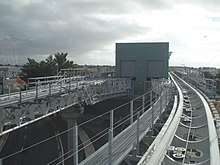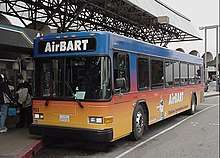Coliseum–Oakland International Airport line
The Coliseum–Oakland International Airport line, also known informally as the BART to OAK line,[1] is an automated guideway transit (AGT) system operated by Bay Area Rapid Transit (BART) between BART's Coliseum station and Oakland International Airport station. The system opened for revenue service on November 22, 2014[2] and is integrated into BART’s fare system. During planning and construction, it was known as the Oakland Airport Connector (OAC) project.
Oakland Airport Connector cable car in 2018 | ||||||||||||||||||||||||||||||||||||||||||||||||||||||||||||||||||||||||||||||
| Overview | ||||||||||||||||||||||||||||||||||||||||||||||||||||||||||||||||||||||||||||||
|---|---|---|---|---|---|---|---|---|---|---|---|---|---|---|---|---|---|---|---|---|---|---|---|---|---|---|---|---|---|---|---|---|---|---|---|---|---|---|---|---|---|---|---|---|---|---|---|---|---|---|---|---|---|---|---|---|---|---|---|---|---|---|---|---|---|---|---|---|---|---|---|---|---|---|---|---|---|---|
| Owner | BART | |||||||||||||||||||||||||||||||||||||||||||||||||||||||||||||||||||||||||||||
| Locale | Oakland, California, United States | |||||||||||||||||||||||||||||||||||||||||||||||||||||||||||||||||||||||||||||
| Transit type | Automated guideway transit (AGT) | |||||||||||||||||||||||||||||||||||||||||||||||||||||||||||||||||||||||||||||
| Number of stations | 2 | |||||||||||||||||||||||||||||||||||||||||||||||||||||||||||||||||||||||||||||
| Website | Bay Area Rapid Transit | |||||||||||||||||||||||||||||||||||||||||||||||||||||||||||||||||||||||||||||
| Operation | ||||||||||||||||||||||||||||||||||||||||||||||||||||||||||||||||||||||||||||||
| Began operation | November 22, 2014 | |||||||||||||||||||||||||||||||||||||||||||||||||||||||||||||||||||||||||||||
| Operator(s) | BART | |||||||||||||||||||||||||||||||||||||||||||||||||||||||||||||||||||||||||||||
| Character | Mostly elevated, with at-grade and underground sections | |||||||||||||||||||||||||||||||||||||||||||||||||||||||||||||||||||||||||||||
| Number of vehicles | 4 trains | |||||||||||||||||||||||||||||||||||||||||||||||||||||||||||||||||||||||||||||
| Train length | 3-cars | |||||||||||||||||||||||||||||||||||||||||||||||||||||||||||||||||||||||||||||
| Headway | 6 minutes (peak hours) 10–20 minutes (early morning & late nights) | |||||||||||||||||||||||||||||||||||||||||||||||||||||||||||||||||||||||||||||
| Technical | ||||||||||||||||||||||||||||||||||||||||||||||||||||||||||||||||||||||||||||||
| System length | 3.2 mi (5.1 km) | |||||||||||||||||||||||||||||||||||||||||||||||||||||||||||||||||||||||||||||
| No. of tracks | 2 | |||||||||||||||||||||||||||||||||||||||||||||||||||||||||||||||||||||||||||||
| Average speed | 24 mph (39 km/h) | |||||||||||||||||||||||||||||||||||||||||||||||||||||||||||||||||||||||||||||
| Top speed | 30 mph (48 km/h) | |||||||||||||||||||||||||||||||||||||||||||||||||||||||||||||||||||||||||||||
| ||||||||||||||||||||||||||||||||||||||||||||||||||||||||||||||||||||||||||||||
The BART to Oakland International Airport AGT system replaces the former AirBART shuttle bus service. Initially operating between two terminal stations, the system includes provisions for an intermediate third station (Doolittle Station) that may be built at a later date.[3]
Operations

The Coliseum–Oakland International Airport AGT system is operated by BART and is integrated into BART’s existing fare system. However, it does not utilize existing BART rolling stock and it is not physically connected with existing BART tracks. Instead it has its own fleet of AGT vehicles that operate on fixed guideways and are cable-drawn. The guideways and Cable Liner vehicles were built by Doppelmayr Cable Car. The line is designed to have an approximate headway of 4.5 minutes (though it is currently operated with a headway of 6 minutes) and to complete a one-way trip in approximately 8 minutes, with an on-time performance of more than 99.5%.[4][5]
The initial setup is four 3-car trains (113 passengers each train),[6] but the system can accommodate an expansion to four 4-car trains (148 passengers each train). The system has four cable loops and one train per cable. The system uses a pinched-loop configuration, with two lines that merge into a single track just before each terminus. Cars switch cables during dwell time at the station.[7] The trains automatically switch cables four times: once at each end, and halfway between the two stops at the wheelhouse, near the intersection of Hegenberger Road and Airport Access Road. The wheelhouse has four 12-foot (3.7 m) drive wheels that move the cables.
The 3.2-mile (5.1 km) AGT route between Oakland Coliseum Station and the airport is mostly elevated, largely in the median of Hegenberger Road, with one underground section as it passes under Doolittle Drive, and one at-grade section just west of that point, before the AGT enters airport property on an elevated guideway. A maintenance and storage facility is located near the midpoint of the system. A two-person team monitors operation of the system from a central control room in the Doolittle maintenance and storage facility.
The AGT’s connection to the existing BART system at Coliseum Station resembles the AirTrain JFK and AirTrain Newark airport people movers' existing off-airport connections to other rail transit lines. In this case however, both the airport people mover and connecting rail transit are operated by BART and share the same fare system. The Airport station's fare gates are located at Coliseum station, between the line's dedicated platform and the elevated walkway above San Leandro Street linking it to the original platform. Both stations for the line feature platform screen doors – a first for the system.
The line is paralleled by AC Transit route 73, which is less frequent but less expensive. Routes 73 and 805 provide overnight service during hours that the Oakland Airport Connector - and the rest of the BART system - are closed.
Fares
On June 12, 2014, the BART Board of Directors voted to set the base fare for travel on the BART to Oakland International Airport AGT system at US$6.[6][8] The Board left open the possibility that temporary promotional fares could be introduced in the future. In addition, seniors, people with disabilities, and children age 12 and under will be eligible for BART's 62.5% discount. Subject to approval, BART staff planned to recommend at a later board meeting that airport employees continue to pay a discounted fare of US$2 for the trip on the new service.[6] As of November 2016, the line operated with a farebox recovery ratio of 96%.[9] This lower-than-expected revenue, in part due to competition from vehicle for hire companies, resulted in a net operating cost of US$860,000 between 2014 and 2016.[10]
History
AirBART

On July 1, 1977, BART began a shuttle bus service called AirBART that ran to the airport terminals from street level at Coliseum station (thereafter named Coliseum/Oakland Airport). The shuttle ride took ten minutes and cost 50 cents.[11] AirBART was a joint project of BART and the Port of Oakland, which owns and operates the airport.[12][13]
As with other BART-branded connecting buses, AirBART was run by private operators under contract. It was operated by Veolia Transport (Shuttleport) from 2001 to 2012, then by Ampco until 2014.[14][15][13] The diesel bus fleet was replaced by compressed natural gas buses around 2008.[16]
At the time of replacement, AirBART ran from 5:00am (8:00am on Sundays) to midnight - approximately matching BART operating hours - with nominal headways of ten minutes at most times. Travel time was estimated as 15 minutes.[17] However, travel times and frequency were inconsistent due to traffic congestion from commuters and Oakland–Alameda County Coliseum events.[18]:S-8 Passengers were required to pay the $3 fare with exact change or a $3 BART ticket from dedicated fare machines.[17] Because of a dispute between BART and the Port of Oakland about who would pay to modify fare equipment, Clipper Card readers were never installed on the buses.[19]
Ridership was 85,000 monthly (about 2,800 per day) in 2008, but dropped to 1,900 daily riders by 2014.[20][21] AirBART service was discontinued on November 22, 2014 when the Oakland Airport Connector opened, though buses were kept on standby for one week in case the new line experienced failures.[13] The buses were then transferred to airport parking shuttle buses to replace diesel buses.[13]
Funding
The U$484 million[2] for funding the project came from local government funds (US$275 million, or 57%), state funds (US$79 million, 16%), federal funds (US$25 million, 5%), and BART deficit spending (US$106 million, 22%).
In late 2009, just prior to the award of the contract to construct the system, the project lost US$70 million of federal stimulus funding because the US Federal Transit Administration (FTA) found that BART was out of conformance with Title VI of the 1964 Civil Rights Act. Among other non-OAC considerations, the FTA cited that BART did not complete the necessary analysis to determine if the future change in service would disproportionately impact low-income or minority communities. The FTA forced the Metropolitan Transportation Commission to reallocate the funding.[22]
By September 2010, all necessary federal and state funding for the Oakland Airport Connector had been re-established, and a groundbreaking ceremony was held on October 20, 2010 featuring key administrators: BART Director Carole Ward Allen, Congresswoman Barbara Lee, State Assemblyman Sandré Swanson, Oakland Mayor Ron Dellums and Oakland City Councilman Larry Reid.[23]
References
- "One year marks one million rides on BART to OAK". Bay Area Rapid Transit (BART). November 19, 2015. Retrieved December 28, 2015.
- "New BART service to Oakland International Airport now open". Bay Area Rapid Transit (BART). November 21, 2014. Retrieved December 2, 2014.
- San Francisco Bay Area Rapid Transit District. "BART to OAK Service - Frequently Asked Questions" (PDF). Retrieved March 1, 2018.
- "BART Board awards Oakland Airport Connector contract in historic vote". Bay Area Rapid Transit (BART). December 10, 2009. Retrieved August 17, 2014.
- "Oakland Airport Connector BART Special Board Meeting" (pdf). Bay Area Rapid Transit (BART). December 10, 2009. Retrieved August 17, 2014.
- "BART Board sets fares for BART to Oakland International Airport service". Bay Area Rapid Transit (BART). June 12, 2014. Retrieved August 17, 2014.
- "Oakland Airport Connector". Doppelmayr Cable Car GmbH & Co KG. Retrieved July 15, 2014.
- Cabanatuan, Michael (June 13, 2014). "$6 rides for BART's Oakland Airport Connector". San Francisco Chronicle. Retrieved December 20, 2014.
- Baldassari, Erin (November 27, 2016). "BART's Oakland Airport Connector losing money; Uber, Lyft to blame?". East Bay Times. Retrieved November 29, 2016.
- "BART's Oakland airport connector turning into big money loser". San Francisco Chronicle. March 8, 2017. Retrieved September 6, 2018.
- 1976/77 Annual Report. San Francisco Bay Area Rapid Transit District. 1977. pp. 7–8 – via Internet Archive.
- "AirBART fares going up". San Francisco Business Times. February 21, 2007.
- "Supplemental Agenda - Regular Meeting of the Board of Port Commissioners" (PDF). Port of Oakland. November 13, 2014. p. 17.
- "Agenda - Special Meeting of the Board of Port Commissioners" (PDF). Port of Oakland. July 26, 2012. p. 162.
- Chan, Anne (February 26, 2013). "OAKLAND PRIVATE INDUSTRY COUNCIL RAPID RESPONSE REPORT: 2ND QUARTER OCTOBER, NOVEMBER, DECEMBER 2012" (PDF). System Leadership Committee Of OAKLAND WORKFORCE INVESTMENT BOARD - AGENDA. Oakland Workforce Investment Board. p. 39.
- "Air Quality and Alternative Fuels". Port of Oakland. Archived from the original on January 3, 2010.
- "Departing Oakland International Airport (OAK)". Port of Oakland. Archived from the original on December 3, 2013.
- BART-Oakland International Airport Connector Final Environmental Impact Report/Final Environmental Impact Statement (PDF). San Francisco Bay Area Rapid Transit District. March 2002.
- Kane, Will (October 3, 2012). "Squabbles block Clipper card for AirBART". San Francisco Chronicle.
- Gosling, Geoffrey D.; Wei, Wenbin; Freeman, Dennis (May 2012). "CASE STUDY REPORT: OAKLAND INTERNATIONAL AIRPORT BART CONNECTOR" (PDF). Research Project 2503: Collaborative Funding to Facilitate Airport Ground Access. Mineta Transportation Institute. Archived from the original (PDF) on September 7, 2015. Retrieved March 3, 2018.
- "BART to Oakland airport shuttle ridership rising, but fare decried". East Bay Times. March 28, 2015.
- Mie, Ayako (February 21, 2010). "$70 million for airport connector project to be diverted to regional transit agencies". Oakland North. Retrieved July 15, 2014.
- "BART breaks ground Wednesday on Oakland Airport Connector". Bay Area Rapid Transit (BART). October 20, 2010. Retrieved July 15, 2014.
External links
| Wikimedia Commons has media related to Oakland Airport Connector. |